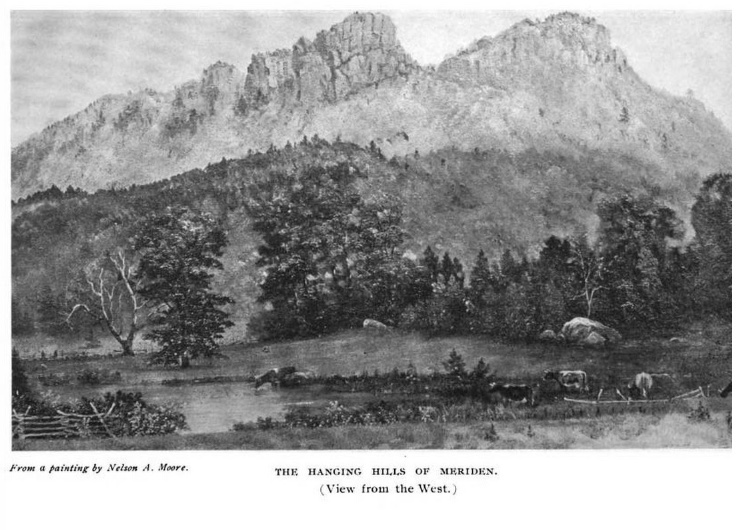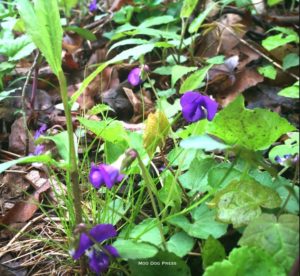Wild and Scenic Walks & Rides: Mr. Hubbard’s Park
During research, a trove of unrelated (but fascinating) information turns up. Flotsam and jetsam of life, advertising, business. So many trails to follow, or not. Focus. Here are maps, tidbits about early technologies, old houses, land formations, geology. Illustrations, people, a toll-gate house. The latter is what led to a man who stayed away from politics yet achieved so much, gave land, created parks.
When the land and waters were more wild but not yet a park, a vision by a man named Walter Hubbard of what could be. And what, in time, did become part of his legacy for a small-in-size (but large-in-ideas impact) state between Boston and New York City.
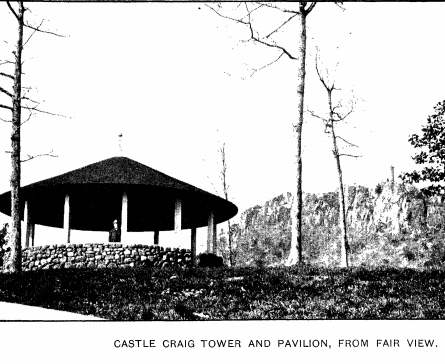
Look closely. Walter Hubbard appears in this image of “Hubbard Park, Meriden Connecticut. Fair View. Walter Hubbard standing next to column.” No date. Circa 1900s. Castle Craig and Pavilion, from Fair View. Figure 1, from U.S. Department of the Interior National Park Service, National Register of Historic Places archives.
But first a visit. Stone steps down to a wading pool, a circular stone-built structure nearby. Thoughts of trout. Fry, fingerling, young, mature fish. Mirror Lake and its original purpose. Spring water sources. Rides to find violets, wildflowers. Acres of resources and retreat possible for families, walkers, runners, hikers. Strands of interviews from those who rode these roads, access from the more remote portion of parklands.
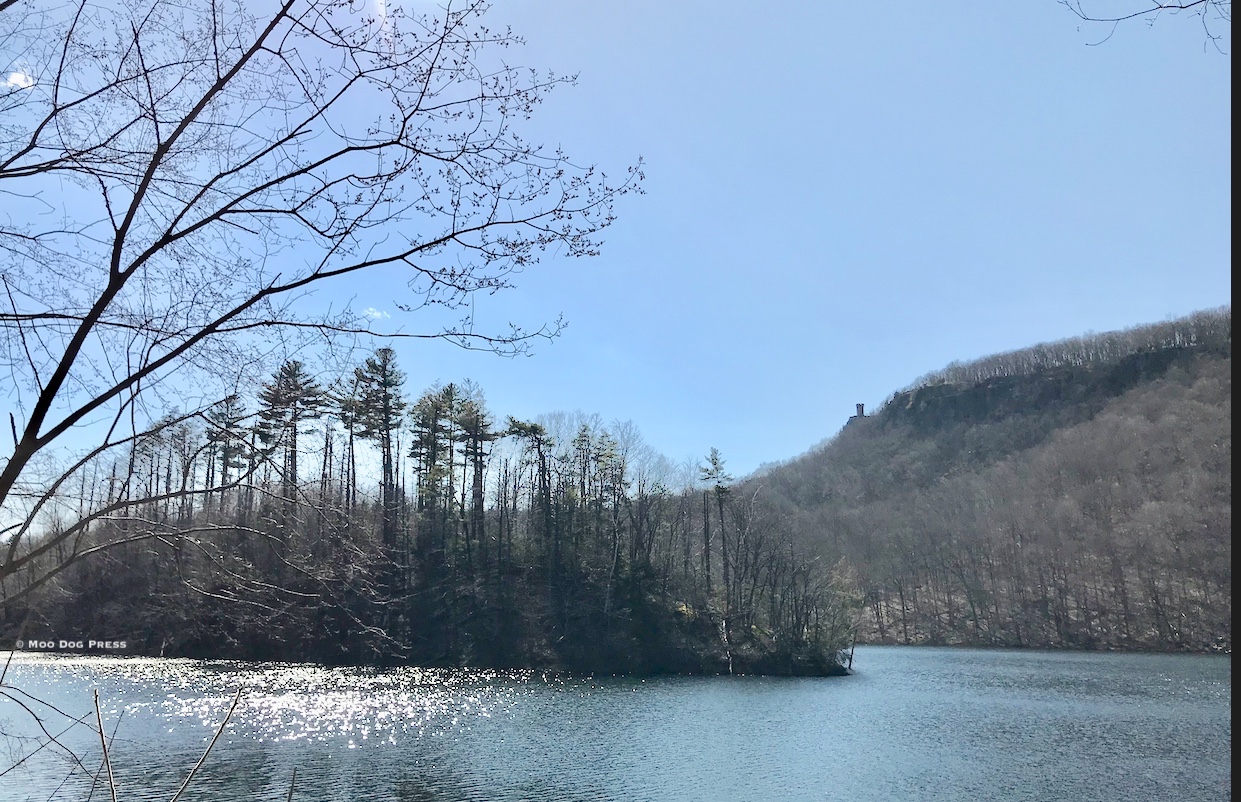
Wild and scenic. Mine Island, Lake Merimere, Castle Craig. Often think of Mr. Hubbard enjoying this same view perhaps from a horse and/or his horse-drawn gig when this was a dirt road. Today, when the gate is open follow the now-paved narrow way to the top of the Hanging Hills.
From a volume of biographical sketches entitled America's Successful Men, published in 1896: Walter Hubbard was born Sept. 23, 1823. in Middletown, Conn.
“Like the majority of the youth of his day, he was brought up on a farm and was educated in the township schools in his vicinity and the Chase Preparatory School of Middletown. At the age of 18, he secured a position as clerk in a country store where, by his thrift, his energy and his strict attention to his employer's interests, he was enabled to accumulate enough capital to embark in business for himself. This he did in 1852, opening a small store in Meriden, Conn., which he conducted until 1860. Mr. Hubbard was married in 1852 to Abby, the daughter of Levi Bradley of Cheshire, Conn. She died a few months after her marriage. Mr. Hubbard has ever since remained single. In 1854, in company with his brother-in-law, N. L. Bradley, Mr. Hubbard founded the Bradley & Hubbard Mfg. Co., of Meriden, and devoted himself entirely to its interest after 1860. The firm so founded has since become the largest manufacturers of its line of goods in the world. Mr. Hubbard is actively connected with many important concerns in Meriden, being president of The Meriden Gas Light Company, also of The Meriden Electric Light Company and The Meriden Trust & Safe Deposit Company. Besides these interests he is also interested as a director in many other local companies. He built The Winthrop Hotel of Meriden (one of the finest hotels in New England), being actuated in so doing, to confer a benefit to the city and not as an investment for himself personally. His gifts to the various charities of his city have been frequent. Politics, strange as it may appear, have never had any attraction for Mr. Hubbard. He has never held, nor sought any public office. In 1883-4 Mr. Hubbard went around the world and he has frequently visited Europe and various parts of the United States in other years.”
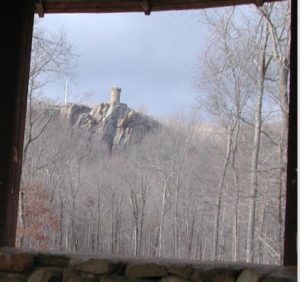
The view from the same structure seen above that depicts Walter Hubbard inside the pavilion, which over time has been restored by the community. A hike to the top and the castle is unforgettable. Fair views in abundance along the way.
Walter Hubbard, land for a park.
From 1899 The Connecticut Magazine, An Illustrated Monthly (600-plus pages, no ads), digitized by Google:
“To the stranger, upon visiting Meriden, Conn., it is a matter of consider able surprise to learn that here is located the largest single public park in New England, and that it is, according to Olmsted Brothers, the celebrated landscape architects, the most striking and interesting reservation of natural scenery for the use of a public park that is possessed by any New England city. We naturally expect that to our cities of the first class would belong the honor of possessing, at least, the largest, if not the most picturesque parks, but here we have a moderate-sized city of only some 30,000 population that has this superiority, both as to area and as to picturesque features. To one man is this splendid example of public spirit and far seeing philanthropy largely due. It is to Walter Hubbard to whom the people of Meriden and the State of Connecticut owe their most profound gratitude, as a beneficient friend, who, by his untiring efforts, his great judgment and forethought has provided for them, and for their children's children for all time, a beautiful garden for rest and recreation. The rich and poor alike may here breathe the same air, enjoy the same scenery, walk side by side along its by paths, ascend the same lofty peaks, stroll through the same ravines and enjoy in common its well-shaded grounds. Hubbard Park, so named after its founder, is a beautiful tract of land of some 800 acres, abounding in features that suggest to the mind the wildness of the primeval period; at the same time, all around you are to be found charming spots of sylvan beauty. Brooklets go rippling down its mountain sides; wild flowers of every hue greet the stroller up hill and down dale; shaded nooks tempt tired limbs to pause and rest, while over all, the great, blue, clear and health-giving air lends its master stroke to complete the picture.
“The scenery of the hills is exceedingly picturesque, the crags being partly, and as it is with extensive tracts and irregular patches of woodland, interspersed with green pastures and dotted here and there with picturesque villages and hamlets. To the ordinary observer, the land which now forms the major part of this park was considered almost worthless, but Mr. Hubbard perceived the great possibilities it held out as a public park. Realizing that the rapid growth of cities means the diminishing in equal ratio of the opportunity for the full enjoyment of out-door life. Mr. Hubbard conceived, and at once proceeded to put into execution, his plan for a park to meet all possible demands of the future. He asked, and received permission of the city authorities, to develop that portion of the land belonging to the municipality, and going deep into his own pockets to purchase additional parcels of territory, and reflections of the surrounding peaks. The old ‘Notch' road, one of the oldest in this section, (at the corner of which once stood the toll-gate house on the Meriden and Waterbury turnpike) carries one through woodland scenes of exquisite loveliness, and brings us to the junction of the main drive at Merimere.
“Here in all its native wildness, filling the space between two precipitous mountains, is the beautiful sheet of water, Lake Merimere, with its wooded island and witnesses of the activity, the rush and go, of our New England towns…
“The drive west from Fair View carries one past great crags of rocks, huge masses of which are detached from fine shore drives. Near this point you take the cliff drive, which gradually and almost imperceptibly ascends the mountain side, until you reach a point called Fair View. Here a most beautiful and impressive panorama greets you. Far away, framed on all sides by purple hills, can be seen, spread out before you like an immense map, one of the most beautiful of valleys. Here and there are towns and cities sending up their myriads of smoke and steam columns — eloquent the mountain precipices, and lie around in wild confusion, and not inaptly give the name of ‘Giant's Play Ground' to the locality…
“This particular place has been of great interest to geologists and to students from our leading colleges. The elder Prof. Silliman said that he had measured some of the largest rocks and, climbing up the face of the crags, located exactly where they had broken away.
“From here a pleasant drive brings us to more restful scenes; pretty forest views, little brooklets lined with mosses and ferns, and all forms of flora that go to show Nature as she is in her quieter moods. If we turn from here, however, and ‘Boulder Bluff,' only a short distance hence, we are ushered to more wildness of scenery and get magnificent views toward the west. From here we enter upon a path which leads us to West Peak, the highest point in the park. The peaks here are also the highest in this visit section of the state, and are designated as the Hanging Hills of Meriden. From the summit of West Peak you can obtain a view not to be equaled anywhere in Connecticut. After a short drive down the mountain we come to ‘Shady Brook,' a name given to a very romantic woodland spot, delightfully cool and rest.
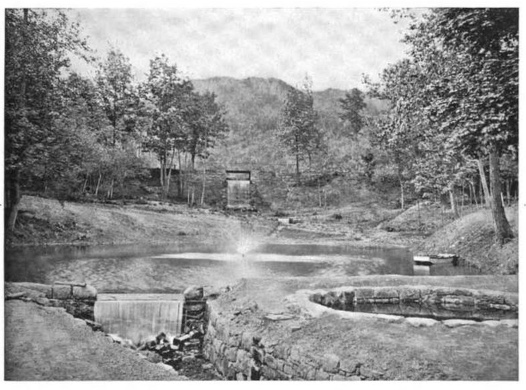
A portion of the park that still looks much the same — but note the circular pond in the foreground. It now has a stone wall surrounding it and more recently contained goldfish.
“In his plan for the park Mr. Hubbard has not forgotten the little folk. They have their playground, with its wading pool, where, with chubby little legs and admirable feature in connection with Mr. Hubbard's work is the fact that he has furnished the funds necessary for carrying on his plans for the park during his life time, and he is still contributing large sums in further improvements; and not only this, he also personally superintends the work. Will not this plan of procedure, in the donor taking upon himself the duty of personally superintending the improvements upon the park, commend itself to all minds as a most sensible way of going about such matters? We have the benefit of the donor's enthusiasm, his judgment and his generous sacrifice of time, great factors that must surely inure to the advantages of the work to be done. It has been an agreeable task, this writing of what one man has done for his city and state. It has been a delightful experience to study his work, to see how it has grown and how much good it is doing. It has been inspiring to note his conception of a civic ideal and the splendid manner in which he has lived up to it. It has been pleasant, indeed, to record these things — to voice the esteem and grateful appreciation that all must feel for the founder of Hubbard Park.”
Note: Though the prose is a bit purple, this selection of an account written in 1899 reflects on the land and terrain given for all as remarkable (and it is). Parklands that despite being bisected for an interstate (the traffic noise is a factor that cannot be mitigated), remain open space for the public. There is an extensive trail system in the park and up to the top of the Hanging Hills. Festivals, graduations, wedding and prom photos, picnics and day outings, all are hosted here. Next: On the trail of old newspaper accounts of the land before the park. Were trout once stocked and raised in what is now known as Hubbard Park, Mirror Lake? And more about the park, a stone-built caretaker's cottage, whimsical and little-known features in the park to find.

